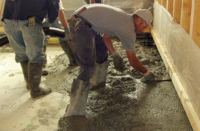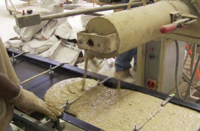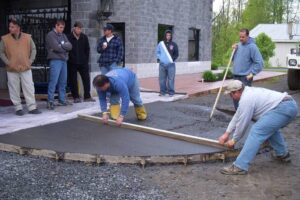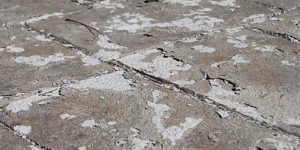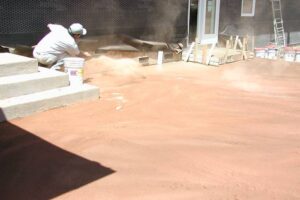Sometimes terminology can be confusing. Take the case of chemical hardeners and densifiers. As Peter Zeh, laboratory manager at Prosoco, points out, the words have somewhat unusual meanings within the realm of concrete.
“Hardener” implies increasing strength and “densifier” implies reducing porosity. Mark Vogel, director of international sales at W.R. Meadows, has a similar view, that a concrete hardener makes the surface of concrete harder and more abrasion-resistant, while a densifier increases the mass per volume. Despite the nuances of the terminology, most people in the industry I spoke with about chemical hardeners and densifiers are of similar mind that chemical hardeners and densifiers are virtually the same thing and the terms are used interchangeably.
One should use caution when using the term “densifier,” however, as the term is trademarked by Applied Concrete Technology Inc., based in Grayslake, Ill. David Johnson, president of the company, says the term has been trademarked since 1991, and that his company’s product is different from others on the market, but more on that later.
There are various classes of hardener/densifier products. Geologist Timothy Murphy at Mineralogy Inc. groups them into three categories: admixtures, dry or shake-on hardeners applied when the concrete is still green, and liquid chemical hardeners/densifiers applied after the concrete is cured. This third category, the one Phil Smith, vice president and technical director of L&M Construction Chemicals calls “post-hardening admixtures,” is the one under discussion here.
Liquid chemical hardeners/densifiers can be further segregated into four types, all silicates, but with different histories. Jeff Koebrick, president of Convergent Concrete, explains that magnesium fluorosilicates are the oldest, having been around for about a century. Sodium silicates were initially developed in Germany in the 1930s. Potassium silicates followed. And the most recent development is the lithium silicates in the late 1990s.
The chemistry of how chemical hardeners/densifiers work is interesting. As you may know, as cement hydrates, it produces calcium silicate hydrate (C-S-H). Basically, as concrete hardens, water reacts with cement to form calcium hydroxide and silica, which react to form C-S-H — the material that bonds the cement with the aggregate in concrete. But the hydration process produces more calcium hydroxide than is used up in this chemical reaction, resulting in excess calcium hydroxide, also called “free lime.” Over the long term, excess free lime is troublesome because it is a primary cause of micro-pitting.
Liquid chemical hardeners/densifiers provide a remedy by introducing additional silicate, which reacts with the excess calcium hydroxide to form more C-S-H. Additional C-S-H means denser, harder concrete. Because the concrete is already dry, this additional chemical reaction initiated by liquid chemical hardeners/densifiers takes place in the capillaries left by water that migrated out of the concrete during the curing process. This filling of the capillaries provides an additional degree of impermeability, but the concrete retains its ability to breathe, allowing water vapor to transpire.
The penetration depth of liquid chemical hardeners/densifiers is where the discussion of chemical hardeners/densifiers can become heated. Smith and others maintain that these products only work in the near-surface wear zone: 4 mm to 5 mm or 1/8 inch to 1/4 inch deep. Johnson says this is because the physical, pencil-like molecular shape of the silicates cannot work their way further down the capillaries. He asserts his densifier, which he describes as having a modified, spherical-shape molecule, can penetrate much deeper. But not everyone agrees.
Add to this the concept that there are different species of silicates. Smith says that within each group of silicates are different species of silicates that vary in their reactive properties based on how various products are manufactured. A less reactive product is not necessarily worse than one that is more highly reactive, but, as Smith observes, “You wouldn’t want to take a Labrador retriever to herd sheep.” In other words, you need to select the product to fit your desired results.
“The biggest problem with these types of products (hardeners/densifiers) is there are no ASTM standards,” Vogel explains. “While a number of manufacturers are working with ASTM to develop these standards, we are probably years away from seeing them used in the industry.”
Other issues revolve around solubility and solids content of these products. Magnesium fluorosilicates, sodium silicates and potassium silicates form soluble bonds. Lithium silicate forms an insoluble bond. Some products have low solids; others have high solids. One is not necessarily better or worse than the other. For example, Sharon Harry, creative director at the International Polished Concrete Institute, explains that in some cases a low-solids product might penetrate a tightly troweled new construction project better and avoid too much product being wasted. On the other hand, an existing floor might need a high-solids product to fill larger voids.
Sometimes the choice of a hardener/densifier is based on economy. Other times the choice is based on the needs of the project. As Koebrick explains, a variety of characteristics differentiate the many liquid chemical hardeners/densifiers on the market, including: abrasion resistance, application rates, chemical resistance, cure time, depth of penetration, ease of application, environmental cleanup, luster/shine, soluble vs. nonsoluble, and versatility as a protective treatment.
Vogel and others recommend that contractors trying to make a decision about liquid chemical hardeners/densifiers ask for and demand independent, third-party laboratory testing to insure accurate results.
What just about everyone agrees on, nonetheless, is that liquid chemical hardeners/densifiers offer wonderful benefits, primarily increased abrasion resistance and a more polishable surface.
Harry says new construction benefits from the increased resistance and a certain amount of water repellency. “These hardeners/densifiers can be built up on the surface and buffed to create a reflective sheen.”
Existing concrete can be helped by liquid chemical hardeners/densifiers, too. Koebrick emphasizes the additives will not “glue together a weak, crumbling or delaminating concrete surface.” But existing floors can gain an extended life with these products. Smith reports there is a lot of interest in refurbishing existing floors using diamond grinders, and liquid chemical hardeners/densifiers are very helpful. Harry explains that diamond grinding “opens the floor by grinding off the worn and stained surface, allowing better penetration, and then you continue to polish using finer diamonds to create a smooth, dense surface.”
Other benefits observed by industry experts include some enhanced protection against staining and freeze-thaw cycle damage, and reduction and mitigation of alkali-silica reaction at the topical surface.
Liquid chemical hardeners/densifiers work well with a variety of decorative concrete techniques, including acid staining, but Zeh recommends that the contractor watch out for incompatibility if a product touts water repellency; after all, you want the acid stain to penetrate the surface. As for the visual effect of these products, he explains, hardeners/densifiers should not alter the look of the concrete very much. “They alter the behavior of the concrete surface.”
Zeh and others caution that, as with many things, too much of a good thing is not always better. This axiom applies to liquid chemical hardeners/densifiers.
Murphy points out that it is not well understood that hardeners/densifiers can be overapplied. “Void space within concrete is typically poorly interconnected, which serves to limit the penetration depth of surface-applied hardener/densifier products. For concrete slabs destined to be covered with impermeable flooring products (such as VCT and epoxy systems), the overapplication or supersaturation of the concrete surface with hardener/densifier products results in the accumulation of metasilicate residues that may contribute to osmosis and flooring system failures.”
Liquid chemical hardeners/densifiers work great if they are used appropriately, and they offer a variety of benefits, including increased durability and longevity of concrete. While they are not new, as more people learn more about liquid chemical hardeners/densifiers and understand how they work, the question may change from “When should you use them?” to “Why would you not?”
